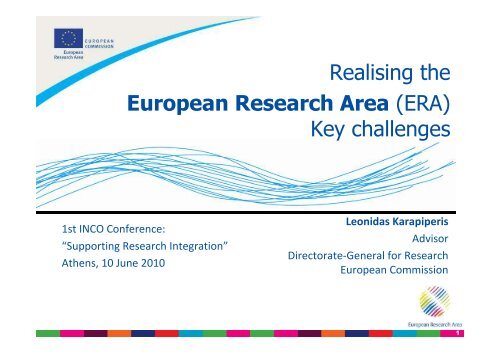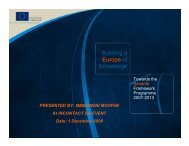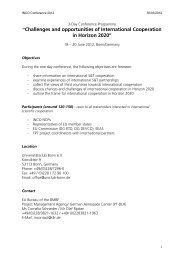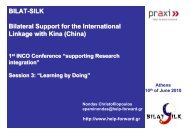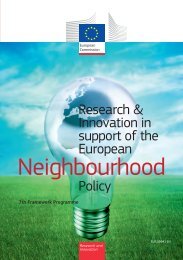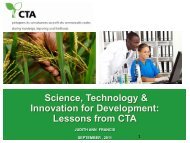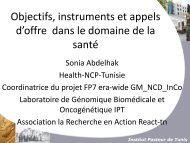Realising the European Research Area (ERA) Key challenges
Realising the European Research Area (ERA) Key challenges
Realising the European Research Area (ERA) Key challenges
Create successful ePaper yourself
Turn your PDF publications into a flip-book with our unique Google optimized e-Paper software.
<strong>Realising</strong> <strong>the</strong><br />
<strong>European</strong> <strong>Research</strong> <strong>Area</strong> (<strong>ERA</strong>)<br />
<strong>Key</strong> <strong>challenges</strong><br />
1st INCO Conference:<br />
“Supporting <strong>Research</strong> Integration”<br />
A<strong>the</strong>ns, 10 June 2010<br />
Leonidas Karapiperis<br />
Advisor<br />
Directorate-General for <strong>Research</strong><br />
<strong>European</strong> Commission<br />
1
Presentation Outline<br />
1. <strong>ERA</strong> and <strong>the</strong> Lisbon Treaty<br />
2. Our global position in figures<br />
3. Current <strong>ERA</strong> initiatives<br />
4. The new context and next steps<br />
2
1. <strong>ERA</strong> and <strong>the</strong> Lisbon Treaty<br />
Main changes and implications for<br />
<strong>the</strong> governance of <strong>ERA</strong><br />
3
Basics of <strong>the</strong> development of <strong>the</strong><br />
<strong>European</strong> <strong>Research</strong> <strong>Area</strong> (<strong>ERA</strong>)<br />
The <strong>ERA</strong> concept launched in 2000, combines:<br />
A <strong>European</strong> “single market" for research, where<br />
researchers, technology and knowledge freely<br />
circulate (“<strong>the</strong> Fifth Freedom”)<br />
Effective <strong>European</strong>-level coordination of national<br />
activities, programmes and policies<br />
Major initiatives implemented and funded at<br />
<strong>European</strong> level<br />
4
<strong>ERA</strong> Vision 2020<br />
<strong>ERA</strong> Vision 2020 adopted at Competitiveness Council on<br />
2 December 2008<br />
“By 2020, all actors fully benefit from <strong>the</strong> ‘Fifth Freedom’ across <strong>the</strong> <strong>ERA</strong>: free<br />
circulation of researchers, knowledge and technology. The <strong>ERA</strong> provides<br />
attractive conditions and effective and efficient governance for doing<br />
research and investing in R&D intensive sectors in Europe. It creates strong<br />
added value by fostering a healthy Europe-wide scientific competition whilst<br />
ensuring <strong>the</strong> appropriate level of cooperation and coordination. It is<br />
responsive to <strong>the</strong> needs and ambitions of citizens and effectively contributes<br />
to <strong>the</strong> sustainable development and competitiveness of Europe.”<br />
5
Lisbon Treaty:<br />
S&T an objective of <strong>the</strong> Union<br />
Explicit recognition of <strong>ERA</strong><br />
S&T from a “means” in <strong>the</strong> prior Treaty, to a fullyfledge<br />
“objective” with <strong>the</strong> Lisbon Treaty<br />
TITLE XIX<br />
RESEARCH AND TECHNOLOGICAL DEVELOPMENT AND SPACE<br />
Article 179<br />
1. The Union shall have <strong>the</strong> objective of streng<strong>the</strong>ning its scientific and<br />
technological bases by achieving a <strong>European</strong> research area in which<br />
researchers, scientific knowledge and technology circulate freely, and<br />
encouraging it to become more competitive, including in its industry, while<br />
promoting all <strong>the</strong> research activities deemed necessary by virtue of o<strong>the</strong>r<br />
Chapters of <strong>the</strong> Treaties.<br />
6
Competence-sharing between <strong>the</strong> Union<br />
and <strong>the</strong> MS<br />
<br />
<br />
Shared competence in <strong>the</strong> R&D area between <strong>the</strong> <strong>European</strong><br />
Union and <strong>the</strong> Member States<br />
Its exercise shall not result in Member States being prevented<br />
from exercising <strong>the</strong>irs<br />
7
2. Our global position in figures<br />
8
The <strong>challenges</strong>:<br />
Globalisation of <strong>Research</strong><br />
Over 75% of global research investment is made outside<br />
<strong>the</strong> EU<br />
Our share is decreasing due to new global players in<br />
S&T<br />
Europe must invest more while opening up to <strong>the</strong> world<br />
9
EU is increasing its investments<br />
in research<br />
All Member States respond by increasing <strong>the</strong>ir R&D<br />
investments in real terms (2000-2008)<br />
19 Member States even managed to increase <strong>the</strong>ir R&D<br />
intensity between 2000 and 2008<br />
10
G r o s s D o m e s t i c E x p e n d i t u r e o n R & D ( G E R D ) - r e a l g r o w t h ( % ) b e t w e e n 2 0 0 0 a n d 2 0 0 8 ( 1 )<br />
5 3 . 0 %<br />
4 9 . 6 %<br />
3 5 . 5 %<br />
3 1 . 4 %<br />
2 8 . 6 %<br />
2 7 . 2 %<br />
2 6 . 6 %<br />
2 4 . 4 %<br />
1 9 . 6 %<br />
1 5 . 6 %<br />
1 2 . 2 %<br />
1 1 . 9 %<br />
9 . 8 %<br />
8 . 8 %<br />
7 . 9 %<br />
6 . 7 %<br />
6 . 7 %<br />
4 . 8 %<br />
1 1 6 . 8 %<br />
7 7 . 0 %<br />
7 2 . 8 %<br />
7 1 . 8 %<br />
6 7 . 7 %<br />
6 0 . 8 %<br />
1 3 7 . 1 %<br />
1 3 3 . 4 %<br />
1 6 0 . 2 %<br />
1 5 4 . 1 %<br />
2 2 1 . 0 %<br />
1 4 6 . 4 %<br />
2 5 8 . 5 %<br />
E s t o n i a<br />
R o m a n i a<br />
C y p r u s<br />
L a t v i a<br />
L i t h u a n i a<br />
P o r t u g a l<br />
T u r k e y<br />
S p a i n<br />
I r e l a n d<br />
C z e c h R e p u b l i c<br />
S l o v e n i a<br />
H u n g a r y<br />
A u s t r i a<br />
B u l g a r i a<br />
F i n l a n d<br />
I c e l a n d<br />
D e n m a r k<br />
L u x e m b o u r g<br />
P o l a n d<br />
G r e e c e<br />
E U - 2 7<br />
U K<br />
I t a l y<br />
N o r w a y<br />
G e r m a n y<br />
S l o v a k i a<br />
M a l t a<br />
B e l g i u m<br />
S w e d e n<br />
F r a n c e<br />
N e t h e r l a n d s<br />
0 2 0 4 0 6 0 8 0 1 0 0 1 2 0 1 4 0 1 6 0 1 8 0 2 0 0 2 2 0 2 4 0 2 6 0 2 8 0<br />
%<br />
S o u r c e : D G R e s e a r c h<br />
D a t a : E u r o s t a t<br />
N o t e s : ( 1 ) T R : 2 0 0 0 - 2 0 0 7 ; E L : 2 0 0 1 - 2 0 0 7 ; S E , N O : 2 0 0 1 - 2 0 0 8 ; M T 2 0 0 4 - 2 0 0 8 .<br />
( 2 ) H U : T h e r e i s a b r e a k i n s e r i e s b e t w e e n 2 0 0 4 a n d t h e p r e v i o u s y e a r s .<br />
( 3 ) F R : T h e r e i s a b r e a k i n s e r i e s b e t w e e n 2 0 0 4 a n d t h e p r e v i o u s y e a r s .<br />
( 4 ) S E : T h e r e i s a b r e a k i n s e r i e s b e t w e e n 2 0 0 5 a n d t h e p r e v i o u s y e a r s .<br />
( 5 ) D K : T h e r e i s a b r e a k i n s e r i e s b e t w e e n 2 0 0 7 a n d t h e p r e v i o u s y e a r s .<br />
( 6 ) N L : T h e r e i s a b r e a k i n s e r i e s b e t w e e n 2 0 0 4 a n d t h e p r e v i o u s y e a r s .<br />
11
EU’s overall R&D intensity<br />
stagnates<br />
However <strong>the</strong> EU’s R&D intensity has stagnated …<br />
…while Asia’s is growing strongly and <strong>the</strong> USA maintains<br />
far higher investments<br />
12
R & D I n t e n s i t y ( G E R D a s % o f G D P ) , 2 0 0 7 ( 1 )<br />
2 , 0 8<br />
1 , 8 7<br />
1 , 8 3<br />
1 , 7 6<br />
1 , 7 0<br />
1 , 6 5<br />
1 , 6 3<br />
1 , 5 4<br />
1 , 5 3<br />
1 , 4 4<br />
1 , 4 2<br />
1 , 2 7<br />
1 , 2 4<br />
1 , 1 8<br />
1 , 1 4<br />
0 , 9 7<br />
0 , 8 6<br />
0 , 8 2<br />
0 , 6 0<br />
0 , 5 9<br />
0 , 5 8<br />
0 , 5 7<br />
0 , 5 6<br />
0 , 5 3<br />
0 , 4 8<br />
0 , 4 6<br />
0 , 4 5<br />
2 , 9 0<br />
2 , 7 7<br />
2 , 6 7<br />
2 , 6 5<br />
2 , 5 5<br />
2 , 5 3<br />
3 , 2 2<br />
3 , 4 0<br />
3 , 3 9<br />
3 , 6 4<br />
4 , 7 4<br />
I s r a e l<br />
S w e d e n<br />
J a p a n<br />
F i n l a n d<br />
S o u t h K o r e a<br />
S w i t z e r l a n d<br />
I c e l a n d<br />
U S<br />
A u s t r i a<br />
D e n m a r k<br />
G e r m a n y<br />
F r a n c e<br />
B e l g i u m<br />
E U - 2 7<br />
U K<br />
N e t h e r l a n d s<br />
N o r w a y<br />
L u x e m b o u r g<br />
C z e c h R e p u b l i c<br />
S l o v e n i a<br />
I r e l a n d<br />
C h i n a<br />
S p a i n<br />
E s t o n i a<br />
P o r t u g a l<br />
I t a l y<br />
H u n g a r y<br />
C r o a t i a<br />
L i t h u a n i a<br />
M a l t a<br />
L a t v i a<br />
T u r k e y<br />
G r e e c e<br />
P o l a n d<br />
R o m a n i a<br />
B u l g a r i a<br />
S l o v a k i a<br />
C y p r u s<br />
0 1 2 3 4 5<br />
13
3. Current <strong>ERA</strong> Initiatives<br />
14
Excellent<br />
research<br />
institutions and<br />
universities<br />
Single labour market<br />
for researchers<br />
<strong>ERA</strong><br />
<strong>ERA</strong> building blocks<br />
World-class<br />
research<br />
infrastructures<br />
Well-coordinated<br />
research programmes<br />
and priorities<br />
(joint programming)<br />
Opening of <strong>the</strong> <strong>ERA</strong><br />
to <strong>the</strong> world<br />
Effective<br />
knowledge sharing<br />
15
<strong>Key</strong> Challenges:<br />
<strong>European</strong> Partnership<br />
for <strong>Research</strong>ers<br />
– Ensure quality and availability of researchers across Europe<br />
and raise <strong>the</strong> attraction of Europe to <strong>the</strong> best research talents<br />
world-wide<br />
• Increasing competition, globally and with o<strong>the</strong>r economic sectors<br />
• Demographic developments affecting Europe's research workforce<br />
• Europe's goal to increase public and private investments in R&D<br />
– Mainstream mobility between institutions, between sectors<br />
and across borders, based on <strong>the</strong> “brain circulation” paradigm<br />
16
<strong>European</strong> Partnership<br />
for <strong>Research</strong>ers<br />
Response to <strong>challenges</strong>:<br />
• A partnership between Member States, Associated States and <strong>the</strong><br />
Commission to accelerate progress, building on reforms and actions<br />
underway<br />
• A common framework to help focus <strong>the</strong> efforts on shared objectives<br />
and key areas of common interest<br />
• A balanced approach: better careers and more mobility<br />
• New voluntary measures to promote <strong>the</strong> Charter & Code principles<br />
(The <strong>European</strong> Charter for <strong>Research</strong>ers, <strong>the</strong> Code of Conduct for <strong>the</strong><br />
recruitment of <strong>Research</strong>ers) at institutional level (“HR Strategy for<br />
<strong>Research</strong>ers”)<br />
• The Gago/Biltgen report of December 2008 with fur<strong>the</strong>r ideas for<br />
implementing <strong>the</strong> Partnership pointing out <strong>the</strong> importance of<br />
education in science.<br />
17
United States<br />
Japan<br />
100000<br />
90000<br />
80000<br />
70000<br />
18<br />
60000<br />
50000<br />
40000<br />
30000<br />
20000<br />
10000<br />
0<br />
Joint Programming:<br />
Restructuring a fragmented <strong>ERA</strong><br />
Public Funding for <strong>Research</strong> (2005 figures)<br />
Joint Programming<br />
in EU 27: 10 to 15 %<br />
EU27 + EC<br />
Joint Programming<br />
in US : 85 to 90 %<br />
Mio Euro<br />
Germany<br />
China<br />
France<br />
UK<br />
Italy<br />
Spain<br />
EC<br />
Ne<strong>the</strong>rlands<br />
Sweden<br />
Belgium<br />
Finland<br />
Austria<br />
Denmark<br />
Portugal<br />
Ireland<br />
Poland<br />
Greece<br />
Czech rep.<br />
Hungary<br />
ROmania<br />
Slovenia<br />
Slovakia<br />
Bulgaria<br />
Luxembourg<br />
Lithuania<br />
Estonia<br />
Cyprus<br />
Latvia<br />
Malta
Why Joint Programming<br />
<strong>Key</strong> Challenges :<br />
Science and Technology can and must contribute to solving major<br />
societal <strong>challenges</strong><br />
Impact of public research not optimised due to fragmentation of<br />
funding in <strong>the</strong> EU<br />
National research programmes have <strong>the</strong>ir place… but are not<br />
equipped to tackle major <strong>European</strong> societal problems by <strong>the</strong>mselves<br />
Response to <strong>challenges</strong> :<br />
Commission Communication on Joint Programming in research adopted<br />
by Council Conclusions (2008)<br />
Member States “in <strong>the</strong> driver seat”, engaging:<br />
• Voluntarily and on <strong>the</strong> basis of variable geometry<br />
• …based on a common vision on how to address major societal<br />
<strong>challenges</strong><br />
• …in <strong>the</strong> definition, development and implementation of common<br />
strategic research agendas<br />
19
What is Joint Programming<br />
<br />
<br />
<br />
<br />
<br />
Joint Programming is a “process”, not a new funding instrument<br />
Possible JPI <strong>the</strong>mes identified by High level Group on Joint Programming<br />
(GPC), installed as a dedicated configuration of CREST. Commission is a<br />
member<br />
Joint Programming Initiatives (JPIs) will combine existing research<br />
programmes and instruments, or build new ones, if necessary<br />
Role of Member States, EuroHORCs/ESF – with <strong>the</strong> support of <strong>the</strong><br />
Commission to consider / develop Framework Conditions<br />
These are boundary conditions such as administrative, normative and<br />
regulatory factors considered essential for <strong>the</strong> effective implementation<br />
and success of JPIs<br />
20
JPIs already launched or to be launched in 2010:<br />
<br />
<br />
<br />
<br />
Combating Neurodegenerative Disesases (including Alzheimer)<br />
Agriculture, Food Security and Climate Change;<br />
A healthy Diet for a healthy Life;<br />
Cultural Heritage and Global Change<br />
Council endorses in May 2010 six new <strong>the</strong>mes (probable launch in 2011):<br />
<br />
<br />
<br />
<br />
<br />
<br />
Joint Programming Initiatives (JPI)<br />
The microbial challenge - An emerging threat to human health<br />
Connecting Climate Knowledge for Europe<br />
More Years, Better Lives - The Potential and Challenges of Demographic Change<br />
Urban Europe - Global Challenges, Local Solutions<br />
Water Challenges for a Changing World<br />
Healthy and Productive Seas and Oceans<br />
21
World-class research<br />
infrastructures<br />
Essential for Europe’s researchers to stay at <strong>the</strong> forefront<br />
of research development<br />
<strong>Key</strong> component of Europe’s competitiveness in both basic<br />
and applied research<br />
<strong>Key</strong> Challenges:<br />
To overcome fragmentation in Europe in <strong>the</strong> field of <strong>Research</strong><br />
Infrastructures<br />
To improve <strong>the</strong> efficiency of services and access to <strong>European</strong><br />
<strong>Research</strong> Infrastructures<br />
To cope with <strong>the</strong>ir increasing cost and complexity<br />
Better implement global Infrastructures<br />
To fur<strong>the</strong>r develop and better exploit <strong>the</strong> potential of e-<br />
infrastructures<br />
Better linkages to innovation<br />
22
The ESFRI roadmap<br />
Identifies 44 new (or major upgrade of) <strong>Research</strong> Infrastructures of pan-<strong>European</strong> interest<br />
The EC funds 3 additional projects from <strong>the</strong> CERN Council strategic roadmap for particle physics*<br />
Social Sc. &<br />
Hum.<br />
( 5 )<br />
Life Sciences<br />
( 10 )<br />
Environmental Sciences<br />
( 10 )<br />
Material<br />
and<br />
Analytical<br />
Facilities<br />
( 6 )<br />
Physics and Astronomy<br />
( 11 )<br />
Energy<br />
( 4 )<br />
e-Infrastructures<br />
(1)<br />
SHARE<br />
BBMRI<br />
ELIXIR<br />
ICOS<br />
EURO-<br />
ARGO<br />
EUROFEL<br />
ELI<br />
TIARA *<br />
ECCSEL<br />
PRACE<br />
<strong>European</strong><br />
Social<br />
Survey<br />
ECRIN<br />
INFRA<br />
FRONTIER<br />
LIFEWATCH<br />
IAGOS<br />
EMFL<br />
PRINS<br />
CTA<br />
JHR<br />
CESSDA<br />
INSTRUCT<br />
EATRIS<br />
EMSO<br />
EPOS<br />
<strong>European</strong><br />
XFEL<br />
SPIRAL2<br />
FAIR<br />
IFMIF<br />
CLARIN<br />
EU-<br />
OPENSCRE<br />
EN<br />
EMBRC<br />
SIAEOS<br />
EISCAT_3D<br />
ESRF<br />
Upgrade<br />
E-ELT<br />
SKA<br />
HiPER<br />
DARIAH<br />
Euro<br />
BioImaging<br />
ERINHA<br />
BSL4 Lab<br />
COPAL<br />
AURORA<br />
BOREALIS<br />
NEUTRON<br />
ESS<br />
KM3NeT<br />
ILC-<br />
HIGRADE *<br />
Distributed research infrastructures<br />
Single sited research infrastructures<br />
ILL20/20<br />
Upgrade<br />
SLHC-PP *<br />
The term “distributed RI”, as used by ESFRI, refers to a facility with one unique name and legal<br />
status, one management structure, one strategy and development plan, and having one annual<br />
report and fiscal address although its research facilities are located in different sites and different<br />
countries<br />
23
Community legal framework<br />
for new research infrastructures<br />
A <strong>European</strong> <strong>Research</strong><br />
Infrastructure Consortium (ERIC)<br />
An easy-to-use legal instrument providing:<br />
<strong>the</strong> spirit of a truly <strong>European</strong> venture<br />
a legal personality recognized in all MS<br />
some privileges / exemptions allowed at a national level for<br />
intergovernmental organisations<br />
Membership:<br />
Member States and Associated Countries<br />
Third States<br />
Intergovernmental organisations<br />
A State may be represented by one or more public entities or private<br />
entities with a public-service mission<br />
24
Opening of <strong>ERA</strong> to <strong>the</strong> world<br />
<strong>Key</strong> Challenges:<br />
Globalisation and global <strong>challenges</strong> (e.g. climate change, energy<br />
security)<br />
Rise of "non-traditional" research partner countries and<br />
research locations ("new global S&T players")<br />
Facilitation of knowledge transfer at global level<br />
The need to ensure equitable and fair access to IP generated in<br />
international R&D collaborations<br />
The need to avoid duplication of activities between <strong>the</strong> Member<br />
States and <strong>the</strong> <strong>European</strong> Community with third country<br />
partners<br />
25
Opening of <strong>ERA</strong> to <strong>the</strong> world<br />
The Commission’s answer: “A Strategic <strong>European</strong> Framework for International<br />
S&T Cooperation“ (September 2008)<br />
based on a long term partnership between <strong>the</strong> Member States and <strong>the</strong><br />
<strong>European</strong> Community<br />
aiming for a more coordinated approach between Member States and <strong>the</strong><br />
<strong>European</strong> Community activities<br />
Endorsed by Council Conclusions of December 2008 “A <strong>European</strong> Partnership for<br />
International Scientific and Technological Cooperation”:<br />
Member States, Associated States and <strong>the</strong> <strong>European</strong> Commission collaborate<br />
to identify common priorities which could lead to coordinated or joint<br />
initiatives and positions vis-à-vis third countries and international fora<br />
inviting Member States and <strong>the</strong> Commission to work tog<strong>the</strong>r in <strong>the</strong> Strategic<br />
Forum for International Cooperation (SFIC)<br />
26
Knowledge transfer and<br />
IP management<br />
<strong>Key</strong> Challenges:<br />
To enhance <strong>the</strong> impact of public research on <strong>European</strong> socio-economic<br />
growth by streng<strong>the</strong>ning knowledge transfer between Public <strong>Research</strong><br />
Organisations (PROs) and <strong>the</strong> private sector at national, <strong>European</strong> and<br />
international levels.<br />
To improve <strong>the</strong> management of intellectual property arising from<br />
research by PROs (including universities), and <strong>the</strong> development of<br />
relations with <strong>the</strong> private sector.<br />
Response to <strong>challenges</strong>:<br />
Commission Recommendation and Code of Practice (2008) including<br />
key principles for improving national Intellectual Property (IP) and<br />
knowledge transfer policies, and guidance for PROs to set up<br />
institutional policies and knowledge transfer systems.<br />
Council Resolution endorsing and supporting Recommendation and<br />
Code of Practice adopted in 2008.<br />
27
<strong>Research</strong> institutions<br />
Excellent research institutions, including universities: key players in <strong>the</strong><br />
knowledge-based economy development, at <strong>the</strong> heart of <strong>the</strong> knowledge<br />
triangle<br />
No separate <strong>ERA</strong> initiative, but elements firmly incorporated in <strong>the</strong><br />
initiatives, e.g. on researchers and on knowledge transfer<br />
Commission Communication “Modernisation agenda for universities:<br />
education, research and innovation”: research excellence, governance,<br />
funding, partnerships with business, knowledge exchange, networking,…<br />
Largely in hands of Member States and research institutions <strong>the</strong>mselves;<br />
<strong>European</strong> level and national actions politically endorsed by <strong>the</strong><br />
November 2007 Council resolution on <strong>the</strong> modernisation of universities<br />
for Europe’s competitiveness<br />
28
Beyond <strong>the</strong> five initiatives<br />
<br />
<br />
<br />
<br />
<br />
The five initiatives and <strong>the</strong>ir future implementation mark important<br />
milestones in <strong>the</strong> fur<strong>the</strong>r development of <strong>ERA</strong> but <strong>the</strong>re are many o<strong>the</strong>r<br />
issues to be addressed<br />
Better integration of research and innovation<br />
O<strong>the</strong>r current initiatives contributing to advancement of <strong>the</strong> <strong>ERA</strong>:<br />
ERC (external review made, Commission Communication in October)<br />
<strong>European</strong> Institute of Innovation and Technology (EIT)<br />
<strong>European</strong> Strategic Energy Technology Plan (SET)<br />
Maritime research strategy<br />
<strong>European</strong> Technology Platforms (ETP)<br />
JTIs, Art. 169s<br />
Streng<strong>the</strong>ning of synergies between FP7, CIP and Structural Funds<br />
The <strong>European</strong> <strong>Research</strong> <strong>Area</strong> Board (<strong>ERA</strong>B) as <strong>the</strong> new advisory body<br />
responsible for advising <strong>the</strong> Commission on <strong>the</strong> realisation of <strong>the</strong> <strong>ERA</strong><br />
Member States and stakeholders encouraged to identify o<strong>the</strong>r <strong>challenges</strong> and<br />
initiatives<br />
29
4. The new context and next steps<br />
30
New Commission<br />
Europe 2020 Strategy<br />
New Commission (February 2010)<br />
<br />
<br />
Máire Geoghegan-Quinn Commissioner for <strong>Research</strong>, Innovation and Science,<br />
with overarching responsibility for innovation<br />
“Europe 2020” (March 2010), Commission strategy proposal for “smart”,<br />
“inclusive” and “sustainable” growth to exit from <strong>the</strong> crisis<br />
<br />
<br />
<br />
<br />
<br />
<strong>Key</strong> role of <strong>Research</strong> and Innovation confirmed<br />
Overall 3% objective maintained (R&D as percentage of GDP by 2020)<br />
R&I to focus on major societal <strong>challenges</strong> facing Europe and <strong>the</strong> world<br />
Importance of better integration of research and innovation<br />
Both demand and supply side measures<br />
Broad definition of innovation (not just research based)<br />
“<strong>European</strong> Innovation Partnerships” to be launched<br />
Innovation Union<br />
Development of “innovation indicators” and targets<br />
31
Fine tuning FP7<br />
<br />
<br />
Simplification in FP7 and beyond<br />
Commission Communication (April 2010)<br />
Interim evaluation of FP7<br />
<br />
<br />
Time scale:<br />
• Expert Panel Report by end October 2010<br />
• Commission response by end 2010<br />
Inputs: Welcome!<br />
32
Next Steps<br />
<br />
<br />
<br />
Discussion on <strong>Research</strong> and Innovation at Autumn <strong>European</strong> Council<br />
<br />
Introduced by personally by President Barroso<br />
Preceded by Communication on a new <strong>Research</strong> and Innovation Strategy<br />
(September 2010)<br />
Start of preparation of FP8<br />
Series of strategic Commission Communications in first half of 2011<br />
<br />
Stakeholder Consultations<br />
First detailed Commission proposals on FP8 in early 2012<br />
Will have to fit in overall EU Financial Perspectives for <strong>the</strong> next period (2014-<br />
2020)<br />
33
Thank you for your attention!<br />
34


